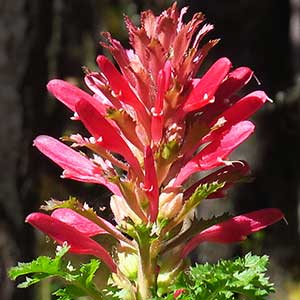Pedicularis densiflora
Pedicularis chamissonis
Indian warrior, warrior's plume
Chamisso's lousewort
basal 1–10, blade lanceolate, 30–200 x 20–70 mm, 2(or 3)-pinnatifid, margins of adjacent lobes nonoverlapping or extensively overlapping distally, 1-serrate, surfaces glabrous, hispid, or downy;
cauline 4–20, blade lanceolate, 15–250 x 5–100 mm, 2-pinnatifid, margins of adjacent lobes nonoverlapping or extensively overlapping distally, serrate, surfaces glabrous, hispid, or downy.
basal 5–15, blade lanceolate, 15–40 x 10–20 mm, 2-pinnatifid, margins of adjacent lobes nonoverlapping or slightly overlapping distally, serrate, surfaces glabrous;
cauline whorled, whorls 1–4, leaves per whorl 3–5, blade lanceolate, 10–60 x 10–30 mm, 1- or 2-pinnatifid, margins of adjacent lobes nonoverlapping or slightly overlapping distally, entire or serrate, surfaces glabrous.
simple, 1–5, exceeding basal leaves, each 10–50-flowered;
bracts lanceolate to trullate, 10–35 x 3–5 mm, undivided or 1-pinnatifid, proximal margins entire, distal 1- or 2-serrate, surfaces glabrous.
verticillate, 1–3, exceeding basal leaves, each 8–20-flowered;
bracts lanceolate to subulate, 10–30 x 5–10 mm, 1-pinnatifid or undivided, margins serrate to 2-serrate, surfaces glabrous.
2–4 mm.
1.5–2.5 mm.
calyx 9–18 mm, downy to tomentose, lobes 5, triangular, 3–4 mm, apex entire, ciliate;
corolla 23–43 mm, tube dark red, purple, or orange-yellow, rarely white, 8–18 mm;
galea dark red, purple, or orange-yellow, rarely white, 15–25 mm, beakless, margins entire medially and distally, apex straight;
abaxial lip dark red, purple, or orange-yellow, rarely white, 8–15 mm.
calyx 6–8 mm, glabrous, lobes 5, triangular, 0.5–1.4 mm, apex entire, ciliate;
corolla 18–20 mm, tube white to pink, 12–15 mm;
galea purple, 6–8 mm, beaked, beak straight, 1–3 mm, margins entire medially and distally, apex extending beyond abaxial lip;
abaxial lip pink or purple, 4–5 mm.
= 16.
Pedicularis densiflora
Pedicularis chamissonis
Scarlet corollas with an undomed, toothless galea and two- or three-pinnatifid leaves are diagnostic of Pedicularis densiflora. This species occurs in forested subalpine regions of southern Oregon, western slopes of the Sierra Nevada, and the Coast Ranges of California south to Baja California. Herbarium records indicate northern populations of P. densiflora occur at higher elevations than do more southern populations.
(Discussion copyrighted by Flora of North America; reprinted with permission.)
Pedicularis chamissonis differs from P. verticillata by having leaves and flowers about 1.5 times larger with a galea that is extended into a conical beak, leaves lanceolate versus elliptic, and lateral lobes of the abaxial lip more than twice the size and more pendulous.
Pedicularis chamissonis is chiefly an Asian species, found on the Kamchatka Peninsula, Kuril Islands, Sakhalin Island, and Japan; the only North American populations occur in the Aleutian Islands of Alaska.
(Discussion copyrighted by Flora of North America; reprinted with permission.)
